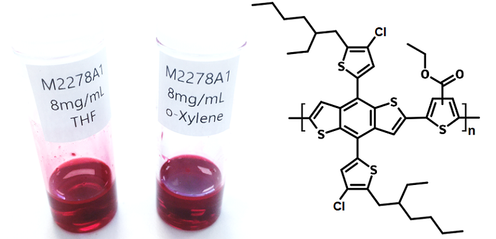PClTO2, eco-friendly green material with high device performance efficiencies
Low cost, high purity polymer available online for priority dispatch
Specifications | MSDS | Literature and Reviews
PClTO2 is an alternating copolymer with benzodithiophene (BDT) and thiophene carboxylate ester as the main backbone units. It has great solubility in the common solvents due to its simple structure.
PClTO2 can be used for highly efficient lower cost non-fullerene polymer solar cells (NF-PSCs) with the advantage of being able to be processed in eco-friendly non-halogenated solvents i.e. THF, o-xylene and 1,2,4-trimethylbenzene.
Wide bandgap copolymer
For high efficient OPV applications
Luminosyn™
High purity, batch-specific GPC data, available larger batch orders and higher molecular weight
Worldwide shipping
Quick and reliable shipping
Green energy materials
Processable in non-halogenated solvents
PClTO2 is first developed at Ossila as one of the green energy materials. Both PClTO2 and PTO2 are eco-friendly green energy materials and good replacements for PM6 and PTB7-Th with simpler structures at lower costs while maintaining high device performance efficiencies. No literature concerning PClTO2 or the same chemical structure was detected at the time of the product launch at Ossila.
Luminosyn™ PClTO2
Luminosyn™ PClTO2 is now available.
High purity
PClTO2 is purified by Soxhlet extraction with methanol, hexane and chlorobenzene under an argon atmosphere
Batch-specific GPC data
Batch specific GPC data is always available for your thesis or publication
Large-quantity orders
Plan your experiments with confidence with polymers from the same batch
General Information
| Full name | Poly[(2,6-(4,8-bis(5-(2-ethylhexyl)-4-chlorothiophen-2-yl)-benzo[1,2-b:4,5-b’]dithiophene))-alt-(2,2-ethyl-3(or4)-carboxylate-thiophene)] |
| Synonyms | PTO2-Cl |
| Chemical formula | (C41H44Cl2O2S5)n |
| CAS number | n.a. |
| HOMO / LUMO | HOMO = -5.66 eV, LUMO = -3.41 eV (measured, please see characterisations) |
| Soluble in | THF, o-xylene, chloroform, chlorobenzene and dichlorobenzene |
| Recommended Processing Solvents at 10mg/ml | THF (8mg/ml), o-xylene (8mg/ml), chloroform |
|---|---|
| Classification / Family | Organic semiconducting materials, Wide band-gap polymers, Organic Photovoltaics, Polymer solar cells, NF-PSCs, All-polymer solar cells (all-pscs), Clean energy materials. |
Batch Details
| Batch | Mw | Mn | PDI | Stock Info |
| M2278A1 | 73,405 | 27,972 | 2.62 | In stock |
Chemical Structure

MSDS Documentation
Literature and Reviews
- Achieving Over 15% Efficiency in Organic Photovoltaic Cells via Copolymer Design, Y. Cui et al., Adv. Mater., 31 (14), 1808356 (2019); DOI: 10.1002/adma.201808356.
- Wide bandgap polymer donors for high efficiency non-fullerene acceptor based organic solar cells, K. He et al., Mater. Adv., 2, 115 (2021); DOI: 10.1039/d0ma00790k.
- 14.7% Efficiency Organic Photovoltaic Cells Enabled by Active Materials with a Large Electrostatic Potential Difference, H. Yao et al., J. Am. Chem. Soc., 141, 19, 7743–7750 (2019); DOI: 10.1021/jacs.8b12937.

 PClTO2 MSDS sheet
PClTO2 MSDS sheet